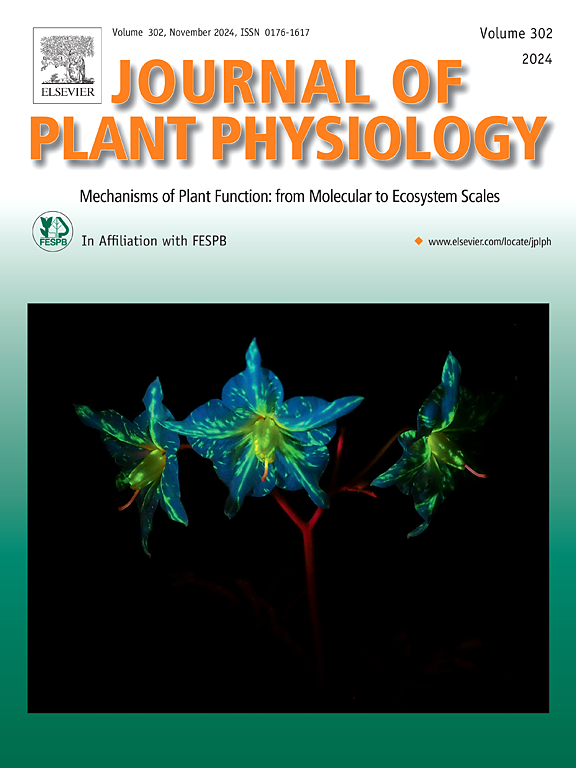Molecular simulation reveals that pathogenic mutations in BTB/ANK domains of Arabidopsis thaliana NPR1 circumscribe the EDS1-mediated immune regulation
IF 4
3区 生物学
Q1 PLANT SCIENCES
引用次数: 0
Abstract
The NPR1 (nonexpressor of pathogenesis-related genes 1) is a key regulator of the salicylic-acid-mediated immune response caused by pathogens in Arabidopsis thaliana. Mutations C150Y and H334Y in the BTB/ANK domains of NPR1 inhibit the defense response, and transcriptional co-activity with enhanced disease susceptibility 1 (EDS1) has been revealed experimentally. This study examined the conformational changes and reduced NPR1–EDS1 interaction upon mutation using a molecular dynamics simulation. Initially, BTBC150YNPR1 and ANKH334YNPR1 were categorized as pathological mutations rather than others based on sequence conservation. A distant ortholog was used to map the common residues shared among the wild-type because the mutations were highly conserved. Overall, 179 of 373 residues were determining the secondary structures and fold versatility of conformations. In addition, the mutational hotspots Cys150, Asp152, Glu153, Cys155, His157, Cys160, His334, Arg339 and Lys370 were crucial for oligomer-to-monomer exchange. Subsequently, the atomistic simulations with free energy (MM/PB(GB)SA) calculations predicted structural displacements engaging in the N-termini α5133-178α7 linker connecting the central ANK regions (α13260–290α14 and α18320–390α22), where prominent long helices (α516) and short helices (α310) replaced with β-turns and loops disrupting hydrogen bonds and salt bridges in both mutants implicating functional regulation and activation. Furthermore, the mutation repositions the intact stability of multiple regions (L13C149-N356α20BTB/ANK-α17W301-E357α21N−ter/coiled-coil) compromising a dynamic interaction of NPR1–EDS1. By unveiling the transitions between the distinct functions of mutational perception, this study paves the way for future investigation to orchestrate additive host-adapted transcriptional reprogramming that controls defense-related regulatory mechanisms of NPR1s in plants.
分子模拟揭示拟南芥 NPR1 的 BTB/ANK 结构域中的致病突变限制了 EDS1 介导的免疫调节功能
NPR1(致病相关基因的非表达因子 1)是拟南芥中由病原体引起的水杨酸介导的免疫反应的关键调节因子。NPR1 的 BTB/ANK 结构域中的 C150Y 和 H334Y 突变抑制了防御反应,实验还揭示了它与疾病易感性增强 1(EDS1)的转录共作用。本研究利用分子动力学模拟研究了突变后 NPR1 的构象变化和 NPR1-EDS1 相互作用的减弱。最初,根据序列保守性,BTBC150YNPR1 和 ANKH334YNPR1 被归类为病理性突变,而不是其他突变。由于这些突变具有高度保守性,因此使用了一个遥远的同源物来绘制野生型之间共有的残基。总体而言,373 个残基中有 179 个残基决定了构象的二级结构和折叠多样性。此外,突变热点 Cys150、Asp152、Glu153、Cys155、His157、Cys160、His334、Arg339 和 Lys370 对寡聚体到单体的交换至关重要。随后,原子模拟自由能(MM/PB(GB)SA)计算预测了连接 ANK 中心区域(α13260-290α14 和 α18320-390α22)的 N 端 α5133-178α7 连接器的结构位移,在这两个突变体中,突出的长螺旋(α516)和短螺旋(α310)被 β 转环和环取代,破坏了氢键和盐桥,这意味着功能调节和激活。此外,突变重新定位了多个区域(L13C149-N356α20BTB/ANK-α17W301-E357α21N-ter/coil)的完整稳定性,损害了 NPR1-EDS1 的动态相互作用。通过揭示突变感知的不同功能之间的转换,本研究为今后的研究铺平了道路,以协调宿主适应性转录重编程,控制植物中 NPR1s 的防御相关调控机制。
本文章由计算机程序翻译,如有差异,请以英文原文为准。
求助全文
约1分钟内获得全文
求助全文
来源期刊

Journal of plant physiology
生物-植物科学
CiteScore
7.20
自引率
4.70%
发文量
196
审稿时长
32 days
期刊介绍:
The Journal of Plant Physiology is a broad-spectrum journal that welcomes high-quality submissions in all major areas of plant physiology, including plant biochemistry, functional biotechnology, computational and synthetic plant biology, growth and development, photosynthesis and respiration, transport and translocation, plant-microbe interactions, biotic and abiotic stress. Studies are welcome at all levels of integration ranging from molecules and cells to organisms and their environments and are expected to use state-of-the-art methodologies. Pure gene expression studies are not within the focus of our journal. To be considered for publication, papers must significantly contribute to the mechanistic understanding of physiological processes, and not be merely descriptive, or confirmatory of previous results. We encourage the submission of papers that explore the physiology of non-model as well as accepted model species and those that bridge basic and applied research. For instance, studies on agricultural plants that show new physiological mechanisms to improve agricultural efficiency are welcome. Studies performed under uncontrolled situations (e.g. field conditions) not providing mechanistic insight will not be considered for publication.
The Journal of Plant Physiology publishes several types of articles: Original Research Articles, Reviews, Perspectives Articles, and Short Communications. Reviews and Perspectives will be solicited by the Editors; unsolicited reviews are also welcome but only from authors with a strong track record in the field of the review. Original research papers comprise the majority of published contributions.
 求助内容:
求助内容: 应助结果提醒方式:
应助结果提醒方式:


